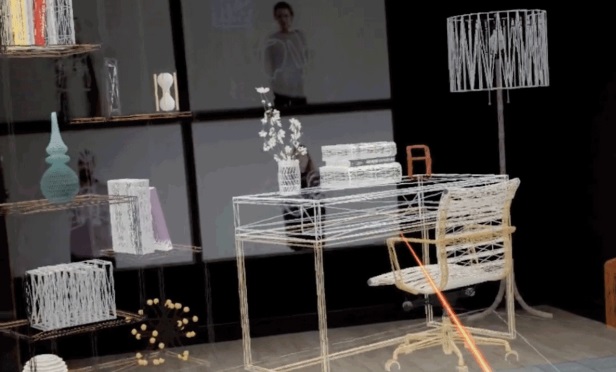 The app will allow prospective renters to digitally view fully furnished multifamily units (credit: roOomy).
The app will allow prospective renters to digitally view fully furnished multifamily units (credit: roOomy).
SAN FRANCISCO—roOomy, a virtual staging, CGI and 3D modeling platform, is partnering with Toll Brothers Apartment Living to create a custom application for Magic Leap's spatial computing device, Magic Leap 1. This partnership is a result of Magic Leap's independent creator program, a grant-based initiative to give developers funding and support to create experiences on the Magic Leap 1, a lightweight wearable augmented reality/AR headset that blends digital and physical worlds.
roOomy was selected from more than 6,500 entries to participate in this program. Through this partnership, the three companies are planning to create an app that will allow prospective renters to digitally view fully furnished and decorated apartment units available for rent in the hopes of improving the leasing process.
roOomy is already known for virtual staging and 3D modeling, particularly when it comes to single-family homes. This new partnership brings roOomy's technology to multifamily renters as well.
In this exclusive, Lindsay Dillon, roOomy vice president of strategic partnerships and marketing, recently discussed how augmented reality and virtual reality/VR have transformed real estate so far, the benefits of leveraging AR/VR in multifamily and for retailers, and what's ahead for the technology.
GlobeSt.com: How have AR/VR transformed the real estate landscape so far?
Dillon: Property owners and developers seeking to market available listings are able to tailor virtually staged spaces in a variety of ways, thanks to augmented reality and virtual reality technologies. Interested parties can experience properties to their fullest potential with digital layouts and configurations instead of physical furniture, while maintaining flexibility to cater to a wider range of prospective tenants. For example, AR/VR technology has created a paradigm shift for multifamily spaces, which traditionally showcase model units with only one configuration/design or unfurnished properties. Now these professionals can allow prospects to overcome key obstacles experienced during their searches, like which sized bed will fit in the bedroom(s) and if a sectional couch will work in the living room without having to bring in the physical pieces.
Additionally, fresh to market developments tend to incorporate numerous layouts and floor plans with the intent of maximizing every square foot of potential real estate, delivering a diversified property that caters to a diverse tenant base–from single professionals to growing families, traditional office layouts to dynamic start-up tech centers. That said, the average prospect struggles to fully grasp floor plan proportions and scale, and it's just as difficult to get an accurate depiction of a space by merely looking at 2D images of empty rooms. That's where AR/VR technology can bring an added scaled-perspective layer to the experience.
GlobeSt.com: What are some of the benefits of leveraging AR/VR when marketing a property? How has AR/VR improved the rental hunt?
Dillon: To reiterate, one of the greatest benefits of AR/VR technology is its ability to improve the showcasing and marketing of properties through nimble digital visuals. You can show off multiple styles and functions without spending an exorbitant amount of time, effort and cost hauling physical furniture into a space for showings and photo shoots.
With 71% of home movers trusting technology to aid home searches, we have seen an uptick in adoption of other visual and immersive technologies including virtual staging over the last decade. AR/VR is no longer just for gaming. At roOomy, we can now pair AR/VR experiences with our virtual staging platform, enabling real estate professionals who are already using our photorealistic renderings to take virtual stagings one step further and into the space themselves, bringing to life a complete walk-through experience with the same designs in the applications that we're developing for mobile and headset devices.
GlobeSt.com: What are the benefits of AR/VR for retailers and what impact will this have on the future of retail?
Dillon: As mobile technology continues to proliferate our lives, retailers are exploring options to improve business metrics through scalable digital tools. Now with digital content, retailers can enhance the selling and buying processes at a scale unavailable until now. AR/VR continues to add to this enhanced buying experience, allowing customers to try before they buy with 3D content that's utilized across applications on our phones and beyond. These companies have a powerful marketing tool that can also positively impact key performance indicators, such as no more expensive photo shoots with physical goods and decreases in costly returns from products that show up and don't work.
GlobeSt.com: What does the future hold for this technology?
Dillon: We are continuing to focus on enterprise tools for the real estate industry that leverage our best-in-class virtual staging services. Just as with our mobile AR efforts, our Magic Leap 1 apps allow users to view the layouts and concepts designed for their specific spaces in a fully immersive headset experience to answer questions like "does this type of sofa make sense in this space?" or "will a king-sized bed fit in the bedroom?" Our mission is to go from toy to tool with AR/VR and soon with our latest QR code enablement feature, users will be able to seamlessly view and explore property-specific designs that they will see online right in front of them while they are visiting the property. We aim to answer questions about the space like "how can I maximize a 650-square-foot studio?" and "how can I add more storage solutions to the bedroom?"
© Touchpoint Markets, All Rights Reserved. Request academic re-use from www.copyright.com. All other uses, submit a request to [email protected]. For more inforrmation visit Asset & Logo Licensing.







